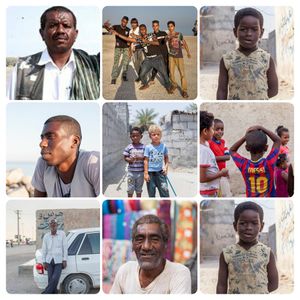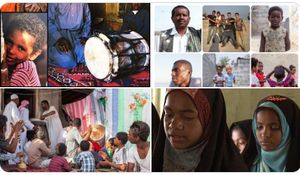الإيرانيون من أصل أفريقي
 | |
| المناطق ذات التجمعات المعتبرة | |
|---|---|
| محافظة هرمزگان, سيستان وبلوچستان,خوزستان | |
| اللغات | |
| Persian, Arabic, Balochi | |
| الدين | |
| الإسلام (predominantly Shia; Sunni) | |
| الجماعات العرقية ذات الصلة | |
| زنج |
| Black people |
|---|
| African diaspora |
| Asia-Pacific |
| African-derived culture |
| History |
| Race-related |
| Related topics |
الإيرانيون من أصل أفريقي (فارسية: ایرانیان آفریقاییتبار)هم أشخاص من أصل أفريقي أسود يقيمون في إيران. يتركز معظم الإيرانيين الأفارقة في المقاطعات الساحلية للخليج العربي مثل محافظة هرمزگان ومحافظة سيستان وبلوچستانخوزستان.[1] أكبر تجمع لهم في مدينة بندرعباس منهم السنة ومنهم الشيعة يتكلمون بلغات المناطق التي يعيشون فيها؛ الفارسية، البندرية، الأچمية أو الخودمونية، البلوشية والعربية يقدر عددهم بمليون نسمة
. . . . . . . . . . . . . . . . . . . . . . . . . . . . . . . . . . . . . . . . . . . . . . . . . . . . . . . . . . . . . . . . . . . . . . . . . . . . . . . . . . . . . . . . . . . . . . . . . . . . . . . . . . . . . . . . . . . . . . . . . . . . . . . . . . . . . . . . . . . . . . . . . . . . . . . . . . . . . . . . . . . . . . . .
التاريخ
بدأت تجارة الرقيق في المحيط الهندي في القرن السادس قبل الميلاد وكانت متعددة الاتجاهات وتغيرت بمرور الوقت. لتلبية الطلب على العمالة الوضيعة ، تم بيع العبيد السود الذين تم أسرهم من قبل تجار العبيد العرب بأعداد كبيرة تراكمية على مر القرون إلى الخليج الفارسي ، مصر ، الجزيرة العربية ، الهند و الشرق الأقصى و جزر المحيط الهندي و إثيوبيا.[2] جاء آخرون كمهاجرين على مر القرون أو من تجار الرقيق البرتغاليين الذين احتلوا جنوب إيران.
خلال عهد أسرة قاجار ، استوردت العديد من الأسر الغنية النساء والأطفال الأفارقة السود كعبيد لأداء الأعمال المنزلية جنبًا إلى جنب مع العبيد الشركس في أوروبا الشرقية. تم جلب هذا العمل بالسخرة إلى حد كبير من الزنج ، الذين كانوا يتحدثون البانتو ويعيشون على طول ساحل جنوب شرق إفريقيا ، في منطقة تضم تقريبًا تنزانيا الحديثة وموزمبيق وملاوي.[3][4] ومع ذلك ، أصدر محمد شاه قاجار ، تحت ضغط بريطاني ، فرمانًا يحظر تجارة الرقيق في عام 1848.[5]
أبرز الإيرانيين من أصل أفريقي
- Abdolreza Barzegari, footballer
- Ali Firouzi, footballer and coach
- Mehrab Shahrokhi, footballer
- Shanbehzadeh Ensemble, Iranian folk band
- Yara Shahidi, Actress, Activist, Model
- Sayeed Shahidi, Child Actor and Model
- Freema Agyeman, Actress
- Dennis Walker, footballer of Afro-Iranian descent, first black player to play for Manchester United[6]
انظر ايضا
- Zanj
- Shirazi people
- Lashar
- Afro-Iraqi
- Afro-Arab
- Afro Turks
- Slavery in Iran
- Haji Firuz
- Bandari music
- Districts of the Achaemenid Empire - note District XVII: "Paricanians and Asiatic Ethiopians"
للاستزادة
- Ehsaei, Mahdi (2015) "Afro-Iran", Heidelberg: Kehrer Verlag, ISBN 978-3-86828-655-7
- Khosronejad, Pedram (2018), ", Unveiling the Veiled: Royal Consorts, Slaves and Prostitutes in Qajar Photographs.", Exhibition Catalogue: 44 pp "Unveiling the Veiled"
- Khosronejad, Pedram (2018), "Re-imagining Iranian African Slavery: photography as material Culture.", Exhibition Catalogue: 24 pp "Re-imagining Iranian African Slavery: photography as material Culture"
- Khosronejad, Pedram (2017), "Qajar African Nannies: African Slaves and Aristocratic Babies.", Visual Studies of Modern Iran 1: 70 pp "Qajar African Nannies"
- Khosronejad, Pedram (2016), "Out of Focus, Photography of African Slavery in Qajar Iran.", The Anthropology of the Contemporary Middle East and Central Eurasia 4: 1–31 "Out of Focus, Photography of African Slavery in Qajar Iran"
- Khosronejad, Pedram (2016), "Photography of African Slavery in Iran.", The Guardian: Interview of Dr. Louise Siddons, Associate Professor of Art History (Department of Art, Oklahoma State University) with Dr. Pedram Khosronejad "Photography of African Slavery in Iran"
- Khosronejad, Pedram (2016), "The face of African slavery in Qajar Iran – in pictures.", The Guardian/"The face of African slavery in Qajar Iran – in pictures"
- Lee, Anthony A. (2012), "Enslaved African Women in Nineteenth-Century Iran: The Life of Fezzeh Khanom of Shiraz.", Iranian Studies 45:3: 417–437, doi:
- Mirzai, B. A. (2002), "African presence in Iran: Identity and its reconstruction in the 19th and 20th centuries", Revue française d'histoire d'outre-mer 89: 336–337
المصادر
- ^ Mirzai, Behnaz. Afro-Iranian Lives (documentary film). afroiranianlives.com. Retrieved 23 November 2011.
- ^ Gwyn Campbell, The Structure of Slavery in Indian Ocean Africa and Asia, 1 edition, (Routledge: 2003), p.ix
- ^ F.R.C. Bagley et al., The Last Great Muslim Empires, (Brill: 1997), p.174
- ^ Bethwell A. Ogot, Zamani: A Survey of East African History, (East African Publishing House: 1974), p.104
- ^ "UNESCO: Fugitive Slaves, Asylum and Manumission in Iran (1851 – 1913)" (PDF). Archived from the original (PDF) on 29 March 2015. Retrieved 13 April 2010.
- ^ Hern, Bill; Gleave, David (30 October 2020). "Dennis Walker: Manchester United's first and only black Busby Babe". theguardian.com. Retrieved 31 October 2020.
وصلات خارجية
- Afro-Iranian Lives (a documentary film by: Behnaz Mirzai)
- Afro-Iran (an ethnographic photography project and book by: Mahdi Ehsaei)
- Afro-Iranians through the Lens of Documentarists (Review of Behnaz Mirzais' documentaries by: Pedram Khosronejad)
- A History of Slavery and Emancipation in Iran, 1800–1929 (Review of Behnaz Mirzai's Book by: Pedram Khosronejad)
الفئة: المنحدرين من أصل أفريقي التصنيف: الشتات الأفريقي في الشرق الأوسط
